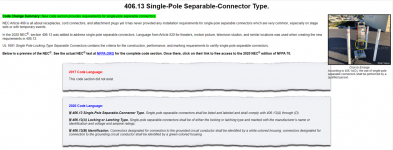busman
Senior Member
- Location
- Northern Virginia
- Occupation
- Master Electrician / Electrical Engineer
All,
You are my best resource for interpretation of new Code rules. Also, if someone could show me how to find the proposal that became this change, I would be indebted. Anyway, there is new language in 406.13 for 2020 about SPSC's. I'm reading this to mean that these can now be used anywhere that Flexible Cords/Cables can be used per 400.7, except for uses (A)(3), (A)(6) and (A)(8) which require an attachment plug. Is this how you all read this? (So you don't need to look it up, (A)(6) is "Connection of utilization equipment to facilitate frequent interchange".)
The specific question is a co-worker wants to use these for a "mobile equipment shelter" made from an Conex Box. This shelter does move from location to location every once in a while, but I would contend that once every few years is stretching "frequently", but that's a separate issue. I contend that this is (A)(6) (and not any other use) and therefore, must have an Attachment Plug. Things are much simpler if I'm wrong, but I want to make sure we are applying this new rule properly.
As always, you are a great resource that I trust more than any other.
Mark

You are my best resource for interpretation of new Code rules. Also, if someone could show me how to find the proposal that became this change, I would be indebted. Anyway, there is new language in 406.13 for 2020 about SPSC's. I'm reading this to mean that these can now be used anywhere that Flexible Cords/Cables can be used per 400.7, except for uses (A)(3), (A)(6) and (A)(8) which require an attachment plug. Is this how you all read this? (So you don't need to look it up, (A)(6) is "Connection of utilization equipment to facilitate frequent interchange".)
The specific question is a co-worker wants to use these for a "mobile equipment shelter" made from an Conex Box. This shelter does move from location to location every once in a while, but I would contend that once every few years is stretching "frequently", but that's a separate issue. I contend that this is (A)(6) (and not any other use) and therefore, must have an Attachment Plug. Things are much simpler if I'm wrong, but I want to make sure we are applying this new rule properly.
As always, you are a great resource that I trust more than any other.
Mark


